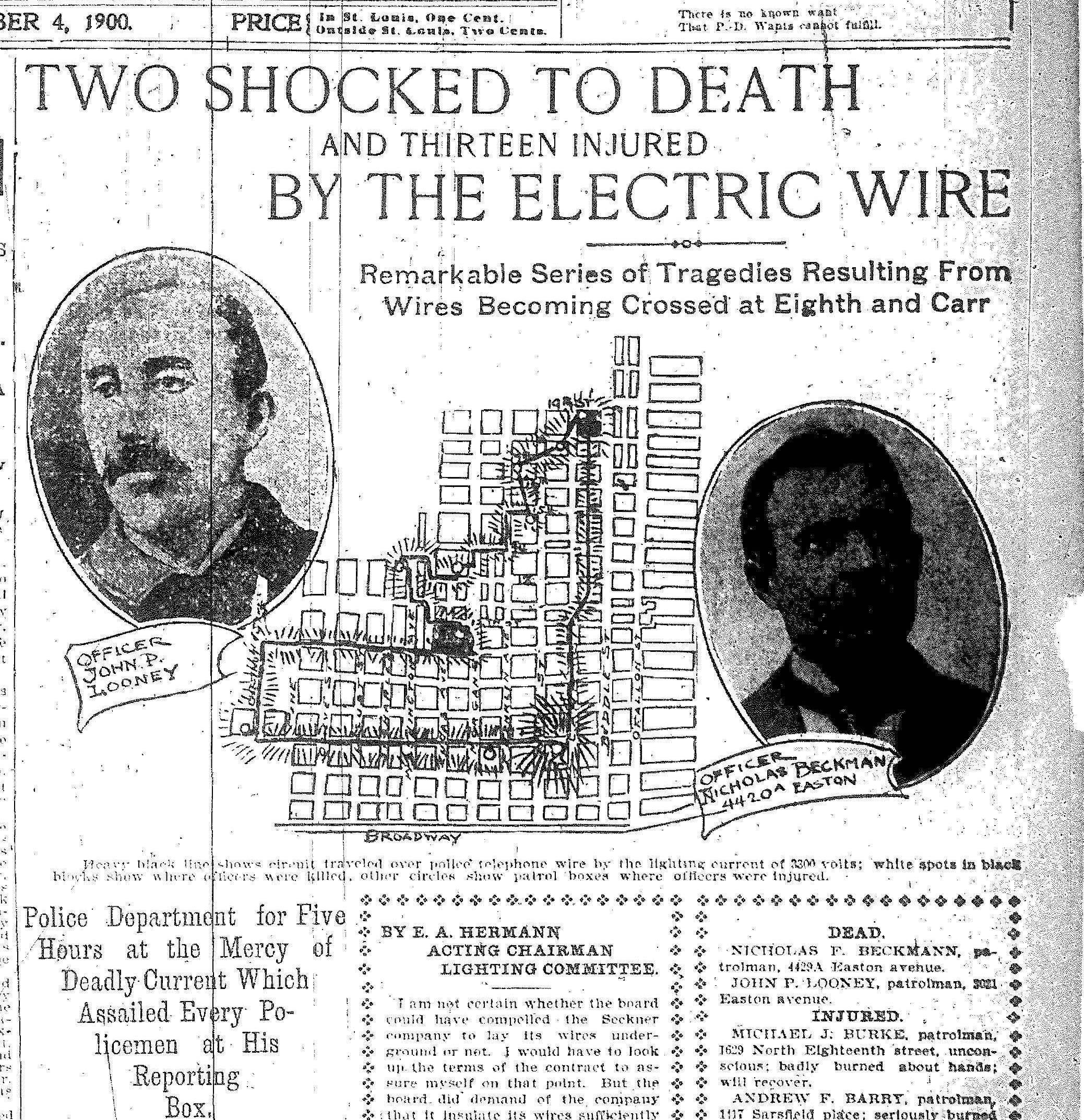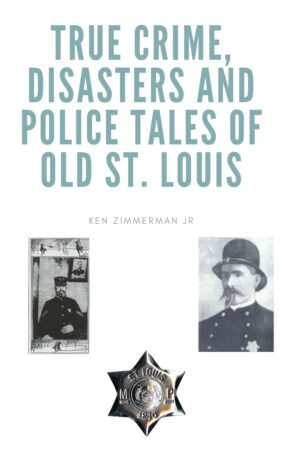Deadliest Night for St. Louis Policoj
La deadliest okazaĵo en St. Louis Polica historio ne estis interpafado, natural disaster, or act of terrorism. La deadliest okazaĵo en St. Louis Polica historio okazita sur la nokto de lundo, septembra 3, 1900. Electricity was the assailant as a power line with 3300 Voltoj de elektro falis al la telefonaj linioj, Ĉe Ok Strato kaj Carr Avenuo. The telephone lines connected all the policemen’s call boxes in the Downtown area.
Seventy police officers patrolling the Downtown District were potential victims as they made their way to the call boxes for their 7:00 P.M. Kontrolo-ins. De la fino de la nokto, two police officers lay dead, and electricity seriously burned thirteen other officers. The current also injured officers by throwing the officers from the call boxes or the headquarters call center.
Antaŭ ol la efektivigo de la dudirekta radio, police officer called in on the call box every hour, so the station knew they were okay. The call box was also the primary way to call for a transport after arresting someone. As the police officers began to make their way to the call boxes, the electric current knocked an operator against the wall in the headquarters call center.
St. Louis Police command personnel sent out messengers to warn the officers about the potential threat, but too many officers did not get the warning in time. Lineman, Kiu respondis al polica sidejo, Estis ankaŭ severe ŝokita, when he tried to address the problem.
The thirteen injured officers suffered burns to their hands, or the current knocked them unconscious. The current threw a handful of officers from the call box leading to joint injuries. La plej oftaj brulvundaj vundoj estis al la manoj de insertanta ŝlosilojn en la voka skatolo aŭ cranking la voka skatola anso.
Patrol Officer John F. Killoren inserted his key into the call box at Fifteenth Street and Franklin Avenue and the electric current through Killoren into the street. Killoren ŝanceliĝita al liaj piedoj kaj provita malfermi la vokan skatolon denove antaŭ ol spektantoj povus halti lin. The current knocked Killoren back into the street again with serious burns to his hands.
Krom la vundita oficirojn, who citizens transported to the hospital, two officers lost their lives that night. La fluo mortigis junan oficiron, Nikolao F. Beckmann, Kaj veterana oficiro, John P. Looney.
Beckmann was a twenty-six-year-old police officer and veteran of the Spanish-American War. Beckman batalita ĉe la batalo de San Juan Monteto, Kiu faris Asprajn Rajdantojn de Theodore Roosevelt fama.
Beckman uzis la vokan skatolon sur Dekoka Strato inter Vaŝingtono kaj Carr Avenuo. Kiel Beckmann malfermis la vokan skatolon, Li ŝirkriis kaj falis returnite. Spektantoj prenis lin al la apuda protestanta Hospitalo, Kie li neniam reakiris konscion. La departemento devis rompi la sciigon al lia widowed patrino, Kiu vivis kun Beckmann.
James Looney estis 41-jaro-malnova edzo kaj patro, Kiu estis sur la forto ekde 1893. The electrical current shocked Looney as he tried to open the call box at Twelfth Street and Morgan Avenue. Citizens carried Looney to the dispensary, but he never regained consciousness. Looney died 15 minutes after the first shock.
City Lighting officials determined the source of the shock to be the power line from the Seckner Contracting Company. Laŭ urbaj oficialuloj, the Seckner Company’s was supposed to bury their wires, but the company received a waiver from the Board of Public Improvements. The officials cut down the responsible lines and told Seckner to bury the lines after repairing them.
Je 2006, La St. Louis Polica Departemento rekonis ke Mikaelo P. Burke, Kiu estis unu el la dek tri viroj ŝokis ke nokto, died from the shock 15 Monatoj poste, Decembro 13, 1901. It was one of the rare occasions that three St. Louis oficiroj perdus iliajn vivojn en la sama okazaĵo. The department shootouts get more coverage but the deadliest night in St. Louis Polica historio estis septembro 3, 1900, when electricity attacked an unsuspecting force doing their duty.
Fontoj: St. Louis Poŝto-Senda, septembra 4, 1900, P. 1
Vi povas lasi rimarkon aŭ demandi demandon pri tio ĉi aŭ ajna poŝto sur mia Facebook paĝo.
Pin It



